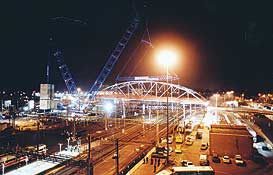The truss is part of a 1,280-ft-bridge that will bring cars directly from downtown New Haven to the waterfront.
 |
| TRUSS-WORTHY Crane configured to 1,500 tons for 176-ft radius lifts truss over rail tracks. (Photo courtesy of O&G Industries Inc.) |
After a year's planning, the May 4 pick took less than its two-hour allotment within a 3-hour window set by the schedule of Metro-North commuter trains that use the New Haven railyard. O&G Industries, Inc., Torrington, Conn., expects to finish the rest of its $31.8-million contract for the Church Street South extension by May 2004, says Kevin Mierzejewski, O&G project engineer.
The state Dept. of Transportation required that the truss, designed by Parsons Brinckerhoff, New York City, be set in a single lift, notes Kahn. So O&G rented a TL 2600 crane from Lampson International LLC, Kennewick, Wash. The firm's $2.5-million subcontract includes four crane operators, supply of the 150-ton rigging, spreader bars and other equipment, and dismantling, says Bill Lampson, president of the firm.
The crane was configured for 1,500 tons at a 176-ft radius, according to Mierzejewski. It has 340 ft of main boom, 3,200 tons of counterweight and 51,000 ft of 1.5-in.-dia cable. "It took two 250-ton cranes, a 45-ton hydraulic crane and a 10,000-lb forklift to put it together," he says.
O&G built 7 piers and two abutments. Crews drove 1,100 75-ft-long concrete piles. "Pile-driving in a railyard is an event," notes Mierzejewski, because trains come in and out for all but a few hours in a 24-hour day. The crews built inspection platforms and stay-in-place decking while National Eastern, Plainville, Conn., fabricated the truss and galvanized it since the railyard location would make maintenance difficult, says Bob Battaglino, National's senior project manager.
The railroad shut off electricity in overhead wires around midnight May 4 for the lift. As 500 people watched, the crane lifted the 60-ft-wide, 55-ft-tall truss on a 186-ft lift radius and carried it over 15 sets of tracks. The 900-ton truss was rotated into position and hoisted onto four main bearings.
f the wind hadn't died down 15 minutes before a scheduled 1,044-ton pick of a 320-ft-long steel truss recently, the Connecticut crew would have had to wait another week to try again. But it did, allowing one of the world's largest cranes to lift the truss 60 ft, rotate it on a 165-ft swing radius and set it down onto preconstructed abutments with an inch of tolerance, recalls Lowell Kahn, vice president of East Granby, CT-based Hartland Building and Restoration, truss erector.
Post a comment to this article
Report Abusive Comment